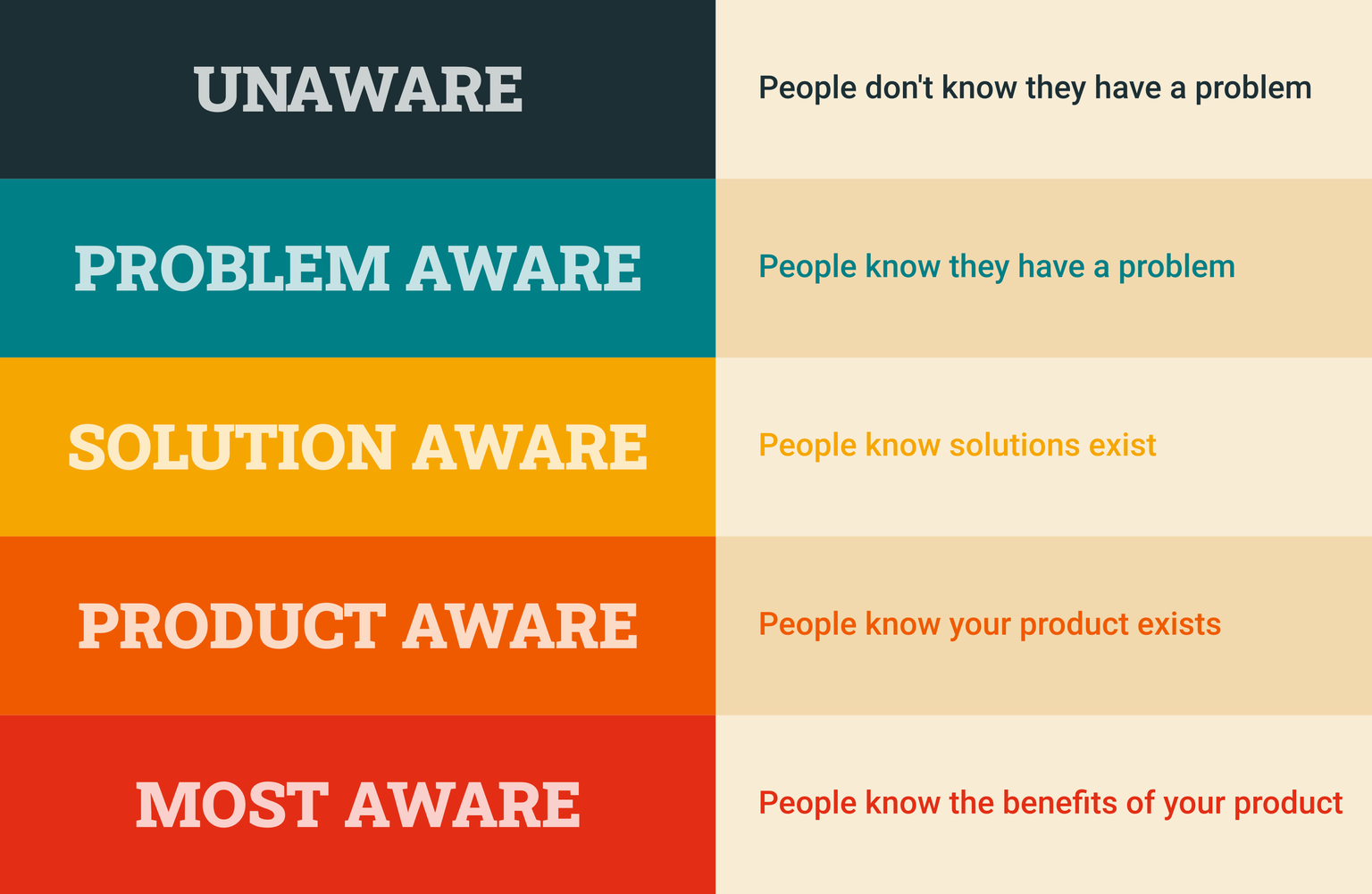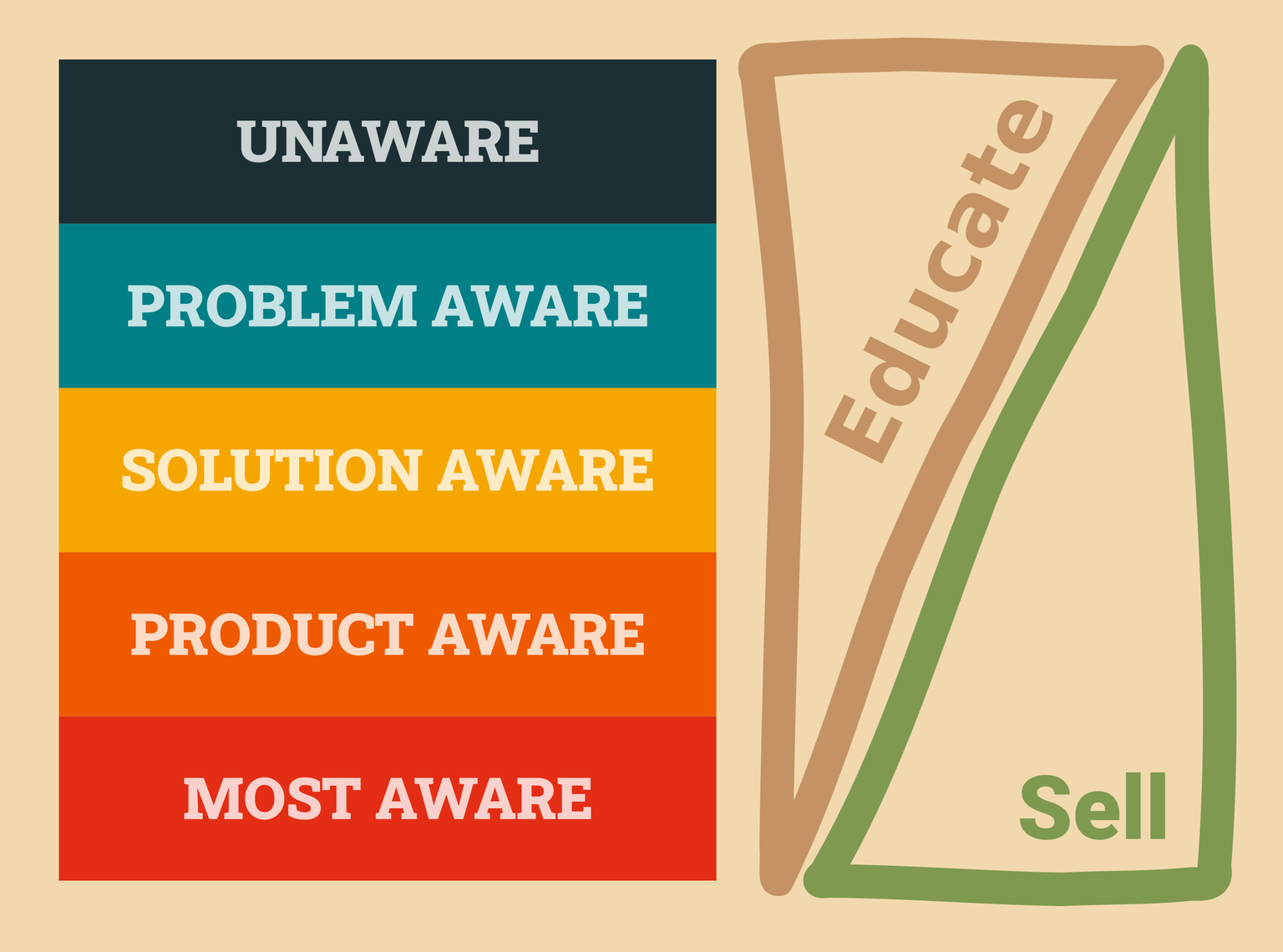Why do some marketing messages hit home while others fall flat? The answer often lies in how well you understand your audience’s level of awareness.
By knowing exactly what your potential customers know about their needs, their favored solutions and your product, you can speak to them in a language that they understand.
The "Five Stages of Awareness" is a concept from Eugene Schwartz’s 1966 book "Breakthrough Advertising". While the book focuses on copywriting for ads, I think the concept of awareness stages should be applied much broader to everything you do in marketing.
I'll first explain the five stages of awareness. And then I'll show you how to use each stage to come up with new marketing ideas. Not just for your ads, but to find specific marketing activities that address people in each stage. Something that takes them from the stage they are currently in to the next one, and the next one. Until they buy from you.
You can take any product or service and any person on the planet. They will be in one of these five stages of awareness:

Let's start at the end and work our way backwards: People buy things because they have a problem and they think that your product or service can solve it. But not everyone realizes that they even have a problem. And so we arrive at the first stage of awareness: Unaware.
People in this stage don't know they have a problem. This is the hardest stage to market to because you must first educate them about their problem.
If you tell them about your product, they won't care. They don't know that they need it.
As an example, let's take a sports watch. Only, if you already know that you want to track your pulse during your workouts, will you be interested in a sports watch. If you don't know that tracking your pulse is important, you won't care about any sports watch let alone their features.
Once people realize that they have a problem, they are problem aware. They are not yet aware of available solutions. So they might try to solve their problem, but they don't know which solutions exist.
If you decide to address problem aware people, you should focus on how your product solves their problem. Or even better, educate them on the available solutions and which one (yours hopefully) is the best.
Returning to the sports watch example: If you know you need to track your pulse, you might not know how to do it. You might not know that a sports watch is one of the solutions. You'll be most interested in learning about the different ways to track your pulse and which one is the best.
Now it gets easier. People in this stage know that they have a problem and they know which solutions exist. They might even know which solution they want.
What they don't know yet is that your product exists.
If you want to address solution aware people, this is the time to explain how your product solves their problem. And why it's better than the other solutions.
In the sports watch example, you know you need to track your pulse and you know that a sports watch with an external heart rate monitor is one of the solutions. It might be the solution you want.
People in this stage know that your product exists. They might even know that it solves their problem. But they don't yet know why they should buy it from you.
This is the stage where you can explain why your product is better than the competition. Why it's best at solving their problem in the specific way they want it solved.
Going back to the sports watch example: If you are product aware, you know that there are sports watches that track your pulse and you know a specific brand. But you aren't sure why you should buy that brand over another.
People in this stage know everything about your product and that they want it. They just haven't bought it yet. They might be waiting for a discount or a little reminder.
This is the time to mention price and specifics on how to buy. If there is a limited-time offer, now is the time to mention it.
This stage builds on all the marketing you did for the previous stages. It's where you close the deal.
In the sports watch example, you more or less have decided on a specific model. For a number of reasons, you just haven't bought it yet. Maybe you are waiting for a discount or you are waiting for the next paycheck or it's a gift you want to receive. But you are so ready that any reason to buy will do. And finally, you buy.
People don't always go through these stages in order. They might have already heard about your product but not know what it does. Or they might know what it does but may not be aware that they need it.
Even if someone moves through all the stages in order, they'll spend more time in some stages than in others. Or some will skip a stage altogether. The journey is not linear and it's different for everyone.
But one thing is certain: If you write the wrong message for the stage that you reach your potential customers in, you won't get through to them. You'll waste an opportunity to move them to the next stage.
In the original book, Eugene Schwartz explains how to use the five stages in copywriting. But you should also use them at a higher level: The stages can help you find the right marketing activities for each stage.

As your prospects move through the stages, they need different information. In the beginning, they have to learn about their problem. And later, they need to know why they should buy from you.
So in the beginning, your emphasis should be on educating. And later, it can transition to selling.
Different marketing activities are better suited for different stages. For example, a Facebook ad is great for people who are at least solution aware. But it will be ineffective for people who are unaware.
On the other hand, writing a guest post on a blog that your target audience reads is great for educating people who are unaware. But it's not the best way to sell to people who are most aware.
Let's look at some examples of marketing activities that we could use for our sports watch example:
At this stage your two main question should be: Where are people hanging out who are interested in the general space? What content will be interesting to them?
Here are some ideas for the sports watch example:
As you can see, it's difficult to separate this stage from the next one. Because it will be hard to talk about pulse tracking without at least mentioning heart rate monitors.
Focus on educating people - just like for the unaware stage. But this time take them from the problem to the solutions.
Some ideas for the sports watch example:
People at this stage start to have the first sliver of a buying intent. They know about the different solutions and they might even know which one they prefer. Now it's time to introduce them to your product.
Some ideas for the sports watch example:
People in this stage know about your product and they are considering to buy it. Now make sure they have all the information they need to make a decision (for your product).
People in this stage are ready to buy. They just need a little push. Push them.
Here the sports watch example is a bit specific because typically hardware like this is sold via retailers. But you could still:
The best way to work through the five stages is to start at the end. Work backwards from the most aware to the unaware.
For each stage, ask yourself:
Then brainstorm marketing activities that will help you reach them at that particular stage.
As you move backwards through the stages towards the unaware, you'll find that the audience gets broader.
If you think about the stages as a funnel, you'll realize that the conversion rate will be highest at the end and extremely low at the beginning. This means, you might be able to afford ads for a later stage, but you'll have to find creative ways to reach people in the earlier stages.
Fortunately, the more you provide value and the less you sell in the earlier stages, the easier it will be for you to get your content in front of people.
It's a great idea to always target several stages at the same time.
Are the Five Stages of Awareness the best and only thing you need? No. But I think they are one of the most powerful tools to have in your marketing toolbox.
Especially if you are stuck in a rut and struggling to come up with new marketing activities. They can open your eyes to broader audiences and new ways to reach new customers.